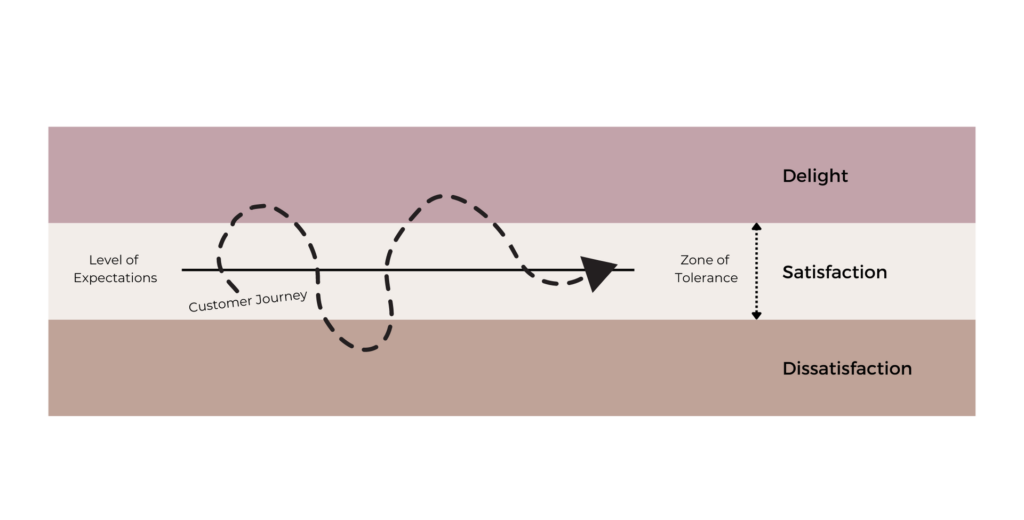Master Customer Experience Management and Get Unlimited Results

Optimize your customers’ experience with customer experience management. Learn how customer experience management works and how to apply it for your business.
The main goal of customer experience management is to make sure every stage of the customer’s journey exceeds their expectations. So your customers will come back time and time again.
Customer experience management is used to create satisfied and delighted customers. The customer experience is everything a customer goes through when they interact with your business. From the first interaction to the final stage of purchasing and using your products. And customer experience management is how you manage your customers’ experience.
Keep reading to learn how to optimize the customer experience. And to ensure that your customers are happy and satisfied when they shop from you.
This article will cover:
What is customer experience management?
Customer experience management is the process of exceeding customers’ expectations. Throughout every stage of your customers’ relationship with you. It means that your customers should have a positive experience every time they interact with your business. No matter what they buy or how they come into contact with you.
The customer experience
The customer experience involves every touchpoint of the customer journey. From the first time your customer comes into contact with you. Such as through market communications, advertising or hearing about you from a friend. To the customer visiting your store, your social media account or your website. The customer experience also includes any interactions after purchasing your product.
Customer experience management means to manage the entire experience the customer goes through. It ensures that you meet the customers’ needs throughout the complete purchasing process. But to be able to meet the needs through every step of the customer journey, you need to know what these steps are. To understand the customer journey better read this guide to the consumer decision making process.
Customer experience vs. customer service
The customer experience does not only mean the service your customers get from your employees. It involves any interaction with your business before, during and after they buy from you. The sum of all these interactions becomes the total customer experience.
Customer service is only one component of the customer experience. Customer service means helping customers when they have an issue. Such as in-store assistance or phone support from an employee. And it is critical for businesses. But it is only one of the factors of a great customer experience.
Why you need customer experience management
The customer experience is a key differentiator from competitors. It can contribute to a successful and profitable business. As a small business you need to use every tool in the toolbox to compete with larger organizations. And that includes customer experience management.
By creating a great customer experience you can build loyal customers that comes back to buy from you again. In addition, customers who are positively surprised by an experience, are more likely to share that experience. They will tell their friends or share their experience on social media. That way they are promoting your product or service for free. Which will also help you gain new customers.
Understand your customers' expectations
Customer experience management is the process of staying ahead of customers’ expectations. To do that, you have to understand your customers’ needs.
Understanding what your specific customers need starts with understanding who your customers are. Which means you need to have a clear idea of your target audience. If you don’t have a target audience you need to define one. In that case, read this article to learn how to conduct a target market analysis.
But defining your target audience is not enough to tailor the experience to them. Therefore, you should also create a customer profile to get down to the nitty gritty details of your target audience. By creating a customer profile you can easier design a customer experience that exceeds their expectations every time. To do that, read this article on how to create a winning customer profile.
Understanding expectations
Now that you have a clear idea of your target audience’s needs, we can dive into how their expectations work.
To exceed customer expectations you need to understand what sets the expectations. And how to achieve customer satisfaction. Satisfaction with an experience is achieved when the customer’s perception of the experience equals the expectations. Meaning that the customer must think the experience was the same as their expectations. If the perception of the experience is not equal to the expectations a gap occurs.
This gap can either be positive; meaning that the experience exceeds expectations. Or it can be negative; meaning that the perception of the experience is less than expectations. You want to make sure to create a positive gap and delight your customers every time. You also want to avoid creating a negative gap.
There are two reasons that a negative gap occurs:
- The customer experience does not match the expectations. The customer could have incorrect expectations due to external reasons. Such as bad marketing promises that are not kept. Or due to internal reasons such as unrealistic, high expectations.
- The customer’s perception of the experience does not match the actual experience. The reason for this could be bad service, or a poorly designed experience in general.
The gap between perception and expectations of the experience are decided by the customer’s expectations. That means if a customer has very low expectations, the experience is perceived as good. When, in fact, the actual experience could be bad. This is because of the customer’s low expectations. Likewise, the experience can also be perceived as negative when a customer has very high expectations. Even though the actual experience was good.
Factors influencing expectations
Because of this it is very important to set the right expectations for your customers. By influencing their expectations. The factors that influences customer expectations are:
- Price (low price, low expectations and high price, high expectations)
- Comparative products/services available and their quality
- Marketing
- Word of mouth including friends’ and family’s recommendations and online reviews
- Previous experiences
- The customer’s mood and attitude
Some of these factors you can’t influence. Such as the customer’s mood, previous experiences or other products on the market.
But you can influence your customers’ expectations through pricing and marketing. By setting the correct price for your product you ensure that the customer’s expectations are met. You should not set a price that is higher than what your product or service actually delivers.
The same goes for marketing. Only make marketing promises you can keep. Through customer experience management you also increase the chances that your business will receive the correct word of mouth.
Customers have a ‘zone of tolerance’ set by their expectations. Any experience within that zone will result in satisfaction with the experience. Any experience above the zone will result in delight. And any experience below the zone will result in dissatisfaction.

Managing the customer’s expectations means understanding what your business is capable of. Then giving clues about it to the customer in the beginning of the customer experience.
Using customer feedback to understand expectations
To better understand the expectations of your customers you need to listen to them. Online feedback is a great place start. Because it creates an open dialogue between your business and your customers that is easy to access.
Social media is excellent for customer feedback. Because you can see what your customers write about you. Check customers’ comments, DMs as well as tags and locations (if your business has one). You can also ask your customers what they think through polls and votes on social media. In addition, Yelp and Google reviews can serve as great tools to get customer feedback.
By listening to all the feedback you receive through reviews, comments or on social media, you will gain access to valuable insights that can help guide your customer experience management.
Managing the customer experience
Now you should understand what expectations your customers have on the experience. You now need to manage the customer experience. With customer experience management, you give the right clues in the beginning of an experience. Then you ensure customer delight by later delivering on them.
It is impossible to ensure that the entire customer experience is flawless for every customer. Because customers will have different previous experiences and expectations. Mistakes happen and things go wrong. But it is how you manage those things that determines your customer’s total experience.
You might think that the perceived quality of a customer experience is the mean of all the individual touchpoints combined. But the customer experience is based on the sum of the best and the worst parts of the experience along with the final touchpoint. This means that a good event and a bad event can cancel each other out.
Crucial moments in the customer experience
There are certain elements that play a larger role in the final grade of the experience. You can use to these to manipulate your customer’s experience:
- The first impression has more impact that the middle of an experience.
- The last touchpoint is the most memorable for customers, and thus plays the most important role.
- High and low events/touchpoints can compensate each other.
- A problem/fault in one part of the experience can result in total expectations becoming higher. Which means the zone of tolerance becomes higher.
- A problem that is resolved well can result in delight.
These factors are important to consider when you are designing your experience. The first and last impressions are the most important and this is where you have a chance to delight your customers.
If something goes wrong during the experience, it doesn’t mean that the customer will be dissatisfied. You need to ensure that the customer complaint is handled very well and the problem solved. Then the customer experience can also result in delight.
Using staff in customer experience management
In customer experience management you need to consider how your staff influences the customer’s experience. While customer service and customer experience management are different, customer service is still a part of customer experience management.
There are three ways employees can affect the customer experience. How your employees (or you) act during these events will affect the customer experience. And whether it results in a positive or negative experience.
The three employee factors that affects customer experience are:
- Employee response to service delivery system failures. How staff responds to failures or problems with the experience. For example:
- Response to unavailability, such as a double booking.
- Response to unreasonably slow service.
- Response to a core fault with the product/service.
- Employee response to customer needs and requests. How staff responds to a customer’s specific needs or requests affects if the customer is satisfied or not. For example:
- Response to customer’s with specific needs
- Response to customer preferences
- Response when the customer has done something wrong
- Response to other customer’s interruptions or inappropriate behavior.
- Unprompted and unsolicited employee actions. Events and actions from staff that surprises the customer can be positive or negative. Which will lead to delight or dissatisfaction. For example:
- Attention that’s been given to the customer
- Staff behavior above and beyond the usual
- Staff behavior according to social/cultural norms
- Extraordinary actions during difficult circumstances
By handling these types of events, you increase your chances of giving the customer a great experience. And making them delighted with your business.
Designing the customer experience
Every customer’s experience is only perceived in the head of that customer. This makes it difficult to design the actual experience. But what you can do is build in the right clues and messages throughout the experience. And try to shape the customer journey to give them the correct experience and emotions.
Start defining your experience with an experience statement. The experience statement is a statement from the customer’s perspective. It includes the emotions and benefits your customers will receive from the experience. It is common to only define the service or product benefits that the customer will receive. But you need to include the emotional experience you want your customers to have.
Think about the emotions that your customer should get after the experience. While most people believe consumers make rational decisions, most decisions are based on emotions. Therefore, you need to deliver positive emotions in the customer experience. Positive emotions creates an emotional bond between the customer and your business. Making it more likely that your customer will come back to buy from you again. As well as give positive feedback to friends and family.
After defining the experience statement you can design the cues and messages you want your customer to get throughout the experience.
Summarizing customer experience management
If you’re a small business owner you need to stay competitive in today’s market. Customer experience management is a way to stand out and make your customers delighted. Understanding customers’ needs will help you craft the best strategy for your business. You need to know what your customers want and what expectations they have on your brand or product. Then you can design an experience that will exceed those expectations.
Customer experience management may seem complex. But it is about understanding your customers, and making sure they have a positive experience every step of the way. Designing a delighting customer experience will result in positive word of mouth about your business. And your customers will come back to buy from you again and again.
If you enjoyed this article please share it with someone else who could benefit from it.

I'm Emma Ellinor
I’m a digital marketer, project manager and retail analyst.
For the past 7 years I have immersed myself into the field of marketing and management. I am on a mission to inspire more women to take their business to the next level. By sharing my journey to escape the 9-5 trap along with useful marketing, time management and small business tips.
